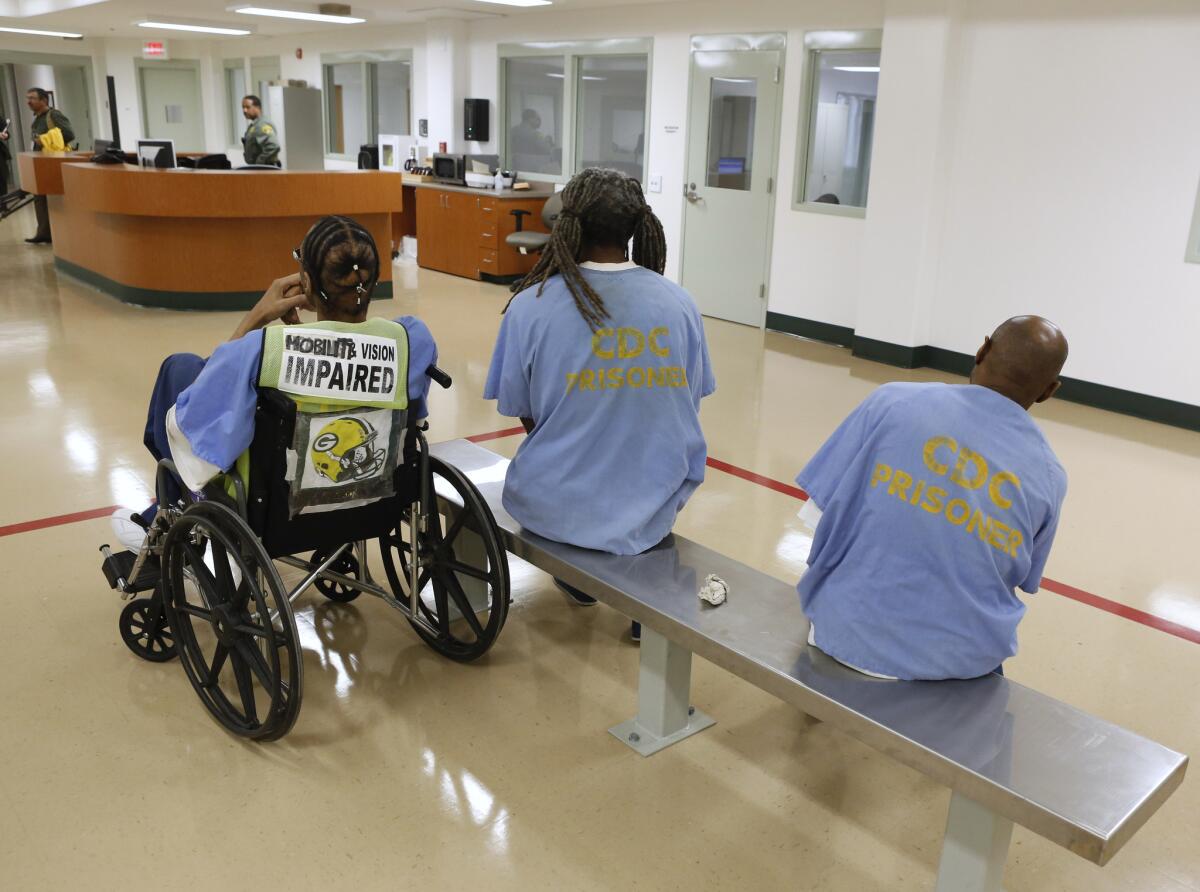Another way on Californiaâs prisons

Gov. Jerry Brown has made it clear how unhappy he is about having to produce a plan to reduce the inmate population of Californiaâs prisons by another 9,000. Under the 2011 realignment law, the state has already lowered the prisoner count by 43,000 by diverting many would-be new prisoners to county jails and many would-be parole violators to county supervision. Besides, the governor has argued, the whole point of the court-imposed population cap â 137.5% of capacity â is to resolve serious problems with inmate medical and mental health care, and hasnât that already been done with an enormous new commitment of resources and treatment?
The Legislature is likewise unhappy about the plan, which the governor filed with the court under protest last week. Many Republican lawmakers donât even like the fact that prisoners have been diverted under the public safety realignment law, so they especially donât like the prospect of releasing more, even if they are the elderly or frail and pose little risk. And many Democrats, like Senate President Pro Tem Darrell Steinberg of Sacramento, donât like the idea of spending scarce state dollars on the other parts of Brownâs plan: leasing beds in county jails, staffing new quarters or paying the cost of an additional transfer of inmates to fire camps.
Wouldnât it be better, Steinberg asks, and more in the spirit and substance of resolving the underlying problem, to spend any âextraâ money to improve access to mental health services for all Californians?
He makes an interesting point. After all, mental health care was in some sense the original realignment program, and it has left Californians with several decadesâ worth of consequences. Even before the 1990s, when responsibility for mental health care was spun off from Sacramento to the counties, California in effect realigned patients from psychiatric hospitals to the streets and ultimately to jails and prisons, which have become todayâs de facto mental health wards. No, mental illness is not a crime, but the untreated often end up in the criminal justice system because their illness affects their behavior, and incarceration without proper treatment generally makes things worse. Some 40% of state prison inmates suffer from some form of mental illness.
With each stop â from institutions to the streets to the jails and prisons â government vowed funding and other support for community-based mental health care, but it never materialized on the scale that was needed. Now many mentally ill prisoners are getting realigned yet again from prison to the street, and they can be expected to keep shuttling to jail and back unless the promise of community-based care is finally realized.
Voters in 2004 did some belated triage by passing Proposition 63 (authored by Steinberg), which directs money from a new income tax bracket from the wealthiest California taxpayers to mental health programs. But itâs not enough. Now Steinberg has a plan to provide counties with grants to fund crisis support teams to assist mentally ill people leaving emergency rooms and jails, and to fund short-term residential beds to get them assessed and directed to treatment rather than allowing them back on the treadmill of neglect and incarceration. Resources may be available as the federal Patient Protection and Affordable Care Act â Obamacare â is implemented.
And there may be some small amount of âextraâ funding available as Brownâs team crunches its April tax receipt numbers and prepares to release its revised 2013-14 budget next week.
Doesnât it make more sense to spend that money on programs to treat mental illness, and in so doing stop more patients from turning into criminals and then inmates, instead of using it to move the people weâve already failed from state prison to other types of incarceration?
Both Steinberg and Assembly Speaker John A. PerĂŠz, a Los Angeles Democrat, have exercised tough discipline on their houses by suspending or rejecting any bills that would add new programs without funding sources, and theyâve done the same with bills that would send more people to prison in the midst of the inmate crowding and care crisis.
There are good arguments for using available money to restore any of dozens of programs cut over the last lean decade, but Steinberg makes a good case for his mental health program to take precedence because it would likely save money in the long run and, at least as important, it would directly address the underlying cause of the acute prison crowding crisis.
But hereâs the rub: Cutting off the flow of mental patients back to prison wouldnât reduce the current 9,000-inmate excess and thus would not help the state meet the courtâs mandate to reduce the prison population immediately.
So it may be too late. We can hope that itâs an alternative that the U.S. Supreme Court would consider in the stateâs appeal of the release order, but thatâs unlikely. We can hope that the three-judge panel that issued the order will note Steinbergâs plan and see the wisdom of opting for it.
But itâs Californiaâs decades of foot-dragging, and the pressure put on by this very release order, that brought us to this point, so the courtâs reluctance to back down is understandable. The trick is to keep the pressure up without forcing the state to reject options that would better meet the underlying rationale for the cap.
Without outside pressure, the promise of community-based care instead of institutionalization for mental patients was never fulfilled. If the state is to get better results from public safety realignment â also a kind of deinstitutionalization â there must be enough money and guidance for counties to follow up this time with smart and efficient community-based care and supervision for all mental health patients in need, and for offenders, mentally ill or not, who might still successfully reenter society without falling into the costly trap of recidivism.
More to Read
A cure for the common opinion
Get thought-provoking perspectives with our weekly newsletter.
You may occasionally receive promotional content from the Los Angeles Times.










